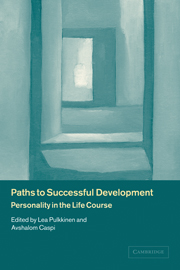Book contents
- Frontmatter
- Contents
- List of contributors
- Personality and paths to successful development: an overview
- Part I Temperament and emotion regulation
- Part II Formation of social relationships
- Part III Continuity in individual life paths
- Part IV Environmental contributions to personality development
- Part V Life transitions
- Part VI Personal goals and well-being
- 13 Individual differences in personal goals in mid-thirties
- 14 Social production function (SPF) theory as an heuristic for understanding developmental trajectories and outcomes
- 15 Searching for paths to successful development and aging: integrating developmental and action-theoretical perspectives
- Index
- References
15 - Searching for paths to successful development and aging: integrating developmental and action-theoretical perspectives
Published online by Cambridge University Press: 22 September 2009
- Frontmatter
- Contents
- List of contributors
- Personality and paths to successful development: an overview
- Part I Temperament and emotion regulation
- Part II Formation of social relationships
- Part III Continuity in individual life paths
- Part IV Environmental contributions to personality development
- Part V Life transitions
- Part VI Personal goals and well-being
- 13 Individual differences in personal goals in mid-thirties
- 14 Social production function (SPF) theory as an heuristic for understanding developmental trajectories and outcomes
- 15 Searching for paths to successful development and aging: integrating developmental and action-theoretical perspectives
- Index
- References
Summary
Human ontogeny is characterized by a great openness and plasticity: intentionality, choice, and self-cultivation in personal development are made possible, but at the same time are also necessitated, by the modifiability of developmental trajectories across the life-span. We select and construe our developmental paths according to our self-definitions and identity projects, which are themselves developmental outcomes; as soon as we have formed representations of our self and personal development, these representations in turn guide the actions and decisions through which we shape our development and aging (Brandtstädter, 1998; Pulkkinen and Rönkä, 1994).
We begin our life with an infinity of possible developmental paths; at the end, however, we have realized only one. The one path that eventually constitutes our life history is to a large extent the result of our intentional actions and choices, but it also reflects constraints and contingencies that we have not intentionally chosen. The norms, institutions, and knowledge systems that prevail within a given cultural and historical context constrain our action spaces; historical change and cultural evolution continously create and destroy developmental options. The existential fact of a limited life-time already constrains intentional choice, as well as possibilities of undoing the unintended results of intentional choices. These latter restrictions become particularly salient in later life; with advancing age, we may come to realize that some of our goals may remain forever unachieved.
Humans select and shape their developmental paths under conditions of “bounded rationality” (Simon, 1983).
Information
- Type
- Chapter
- Information
- Paths to Successful DevelopmentPersonality in the Life Course, pp. 380 - 408Publisher: Cambridge University PressPrint publication year: 2002
References
Accessibility standard: Unknown
- 13
- Cited by
